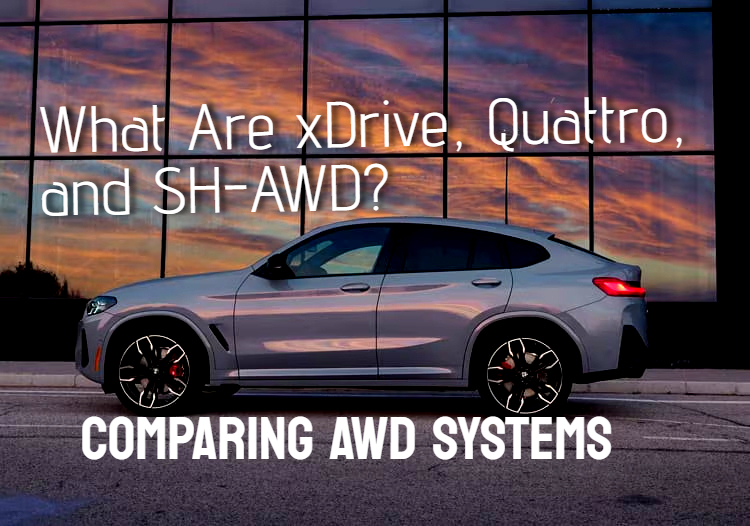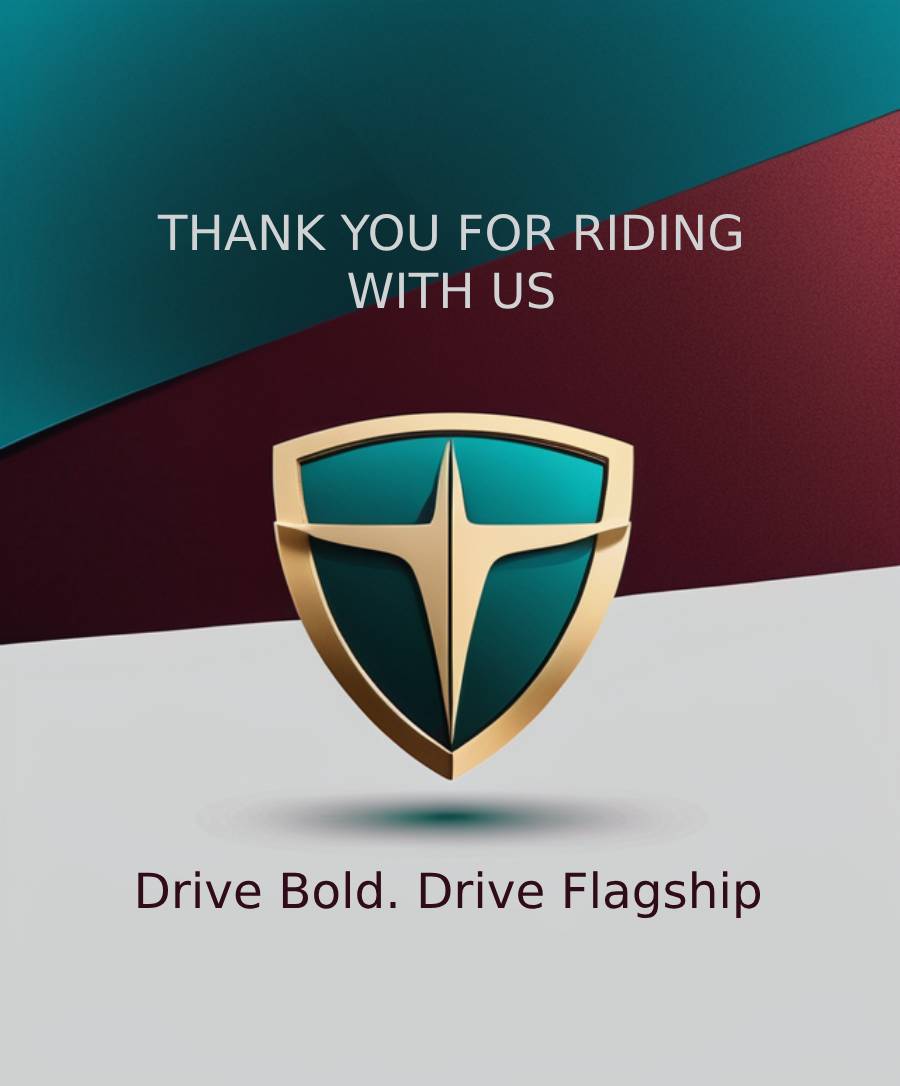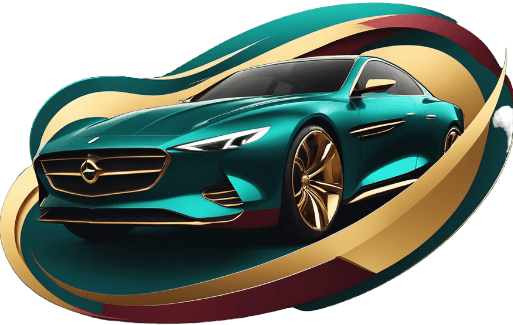Your cart is currently empty!

What are xDrive, Quattro, and SH-AWD? Comparing AWD Systems
All-wheel drive (AWD) systems are equal. And when you come across terms like xDrive, Quattro, or SH-AWD (Super Handling), you’re not just looking at fancy branding. These are proprietary AWD technologies developed by BMW, Audi, and Acura. They all sit under the AWD umbrella, but they work in different ways and are integrated with various brand-specific systems. While they may be different, each of these is designed to enhance traction, handling, and performance.
In this article, I’ll break down how BMW’s xDrive, Audi’s Quattro, and Acura’s SH-AWD work. Together, we’ll compare their strengths and help you understand which AWD system is better for your driving needs. As you’re about to find out, some of these All-wheel drive systems are better suited for daily commuting, winter driving, or spirited cornering on dry roads.
What is the BMW xDrive?
BMW’s xDrive all-wheel drive systems maximize traction in low-grip conditions and enhance driving dynamics. It’s a fully active system that constantly monitors wheel speed, steering angle, throttle input, and brake pressure to anticipate and react to hazards. Unlike other AWD systems, the xDrive is always on, but only steps in when needed, such as on ice, mud, or during sudden changes in direction. And when it steps in, the system redistributes power between the front and rear axles to keep the vehicle stable and in control.
Under normal conditions, xDrive sends 45 percent of engine power to the front wheels and 55 percent to the rear. However, this ratio constantly changes in real-time. The system can push up to 100% of torque to one axle or even a single wheel when necessary. It does this using an electronically controlled multi-plate clutch in place of a traditional center differential. The setup makes the xDrive effective in cold-weather regions, wet roads, or even light off-road terrains. This way, it helps drivers maintain traction without any noticeable input or delay.
Beyond improving safety, the xDrive helps in performance driving. When cornering, the system reduces power to the inner wheels to support rotation, which helps the car exit turns faster. If the vehicle begins to understeer or oversteer, xDrive shifts torque forward or rearward as needed to rebalance the car, foetn before the driver even notices. Working in tandem with BMW’s Dynamic Stability Control (DSC), xDrive also applies brake force to specific wheels when necessary. Despite being a full-time all-wheel drive system, BMW tuned the xDrive to be lighter and more efficient.
ALSO, CHECK OUT: BMW iM3: 700+ HP Electric M3 Spotted Near Nürburgring
What Is The Audi Quattro?
Quattro is Audi’s signature all-wheel drive system. It was developed to deliver constant traction and performance across a wide range of conditions. Unlike traditional front- or rear-wheel drive setups, Quattro sends power to all four wheels. This enhances grip, stability, and control, especially on slippery surfaces like snow, rain, or gravel. Originally introduced in the early 1980s, Quattro was a revolutionary system that helped Audi dominate rally racing and set a new standard for AWD in road cars.
At the core of the Quattro system is a Center differential. This typically splits torque 40% to the front wheels and 60% to the rear during normal driving. This real-biased layout gives Quattro-equipped Audis a more dynamic and performance-focused feel. When road conditions change, the system can redirect torque between the axles almost instantly. Some modern versions include torque vectoring, a feature that sends more power to the wheels with the most grip. This is especially helpful during aggressive cornering. Quattro also works with Electronic Stability Control (ESC) to maintain composure in sharp maneuvers or low-traction situations.
The Quattro has so many advantages. One of these is the improved traction in poor weather. It also sharpens handling in spirited driving and helps you maneuver a car better in emergencies. However, it does have its trade-offs. The system adds weight to the vehicle, which can impact fuel efficiency. The Quattro system is also complex, so it comes with higher manufacturing and maintenance costs. Still, for many drivers, the Quattro all-wheel drive system is among the most respected technologies.
ALSO, CHECK OUT: 20 Best Features Of The 2024 Audi Q8 Plug-In Hybrid
What Is The Acura SH-AWD?
SH-AWD, short for Super Handling All-Wheel Drive, is Acura’s advanced torque-vectoring AWD system. It was designed to deliver traction and, as the name states. Dynamic handling. The brand was introduced in 2005. It was the world’s first production AWD to actively distribute power, not just between the front and rear axles, but also between the left and right rear wheels. This added layer of control makes SH-AWD one of the most agile and performance-focused AWD systems on the market. The SH-AWD is available on the Acura RDX and other models like the Type S.
What makes SH-AWD so special? SH-AWD can send up to 70% of engine torque to the rear wheels, and then direct 100% of that rear torque to either the left or right wheel. When taking a curve, the system overdrives the outer rear wheel by 2.7%. This helps rotate the car into the turn. This reduces understeering and improves cornering, which is something conventional all-wheel drive systems can’t do. Inputs from the steering, throttle, and stability control systems allow SH-AWD to respond in real-time. It creates a rear-biased feel while maintaining AWD stability.
Now in its fourth generation, SH-AWD is upgraded to be quicker. It is also more compact and capable of handling higher torque, such as in the 355-HP Type S Turbo V6. This AWD is standard on Acura’s Type S models and the RDX, and available on the TLX and MDX. Unlike many AWD systems focused solely on grip, SH-AWD enhances agility, responsiveness, and acceleration. So, Acura is the only premium brand to offer torque-vectoring AWD as its flagship all-wheel drive solution.
ALSO, CHECK OUT: These 2024 Performance Cars Cost Less Than $50,000
Comparing xDrive vs Quattro vs SH-AWD
AWD System Comparison Table
| Feature | BMW xDrive | Audi Quattro | Acura SH-AWD |
| Type | Full-time AWD | Full-time AWD (or on-demand in some models) | Full-time AWD with torque vectoring |
| Torque Bias | Rear-bias (45:55) | Rear-bias(typically 40:60) | Front-biased, up to 70% rear |
| Power Distribution Method | Electronically controlled clutch | Center differential + torque vectoring | Active torque vectoring (rear left/right) |
| Cornering Capability | Reduces under/oversteer dynamically | Strong stability and grip | Overdrives outside rear wheel for sharper turn-in |
| Traction in Poor Conditions | Excellent | Excellent | Excellent, with added agility |
| Performance Focus | Balanced handling + safety | All-weather grip + sporty drive feel | Precision cornering + dynamic response |
| Off-road Capability | Moderate | Moderate to Good | Moderate (traction control helps in sand/mud) |
| Fuel Efficiency | Improved in newer models | Slightly lower due to weight | Efficient for its class, compact design |
| Available On | A lot of BMW models (X, 3, 5, etc.) | A lot of Audi models (A, Q, S, RS lines) | Models like the Acura RDX, TLX, MDX, and Type S models |
Which AWD System Is Right For You?
Here’s how to find out whether the xDrive, Quattro, or the SH-AWD is good for you.
- If you want something that feels rear-wheel drive but handles winter, pick the xDrive
- If you need all-weather confidence and a legacy of AWD excellence, pick the Quattro
- If you want agility with the grip of AWD, choose the SH-AWD.
Author Details

Our Team
Hi there! Welcome to Flagship Drive.
I’m Wilfred Nkhwazi, a passionate car lover from Africa. I created this platform to share expert insights, honest reviews, and a fresh perspective on the latest cars and automotive trends. Let’s hit the road together.
Advertisement

Recent News

